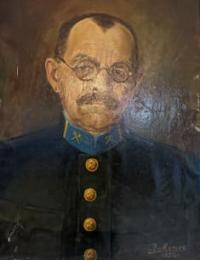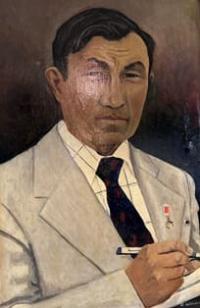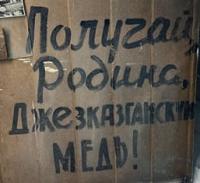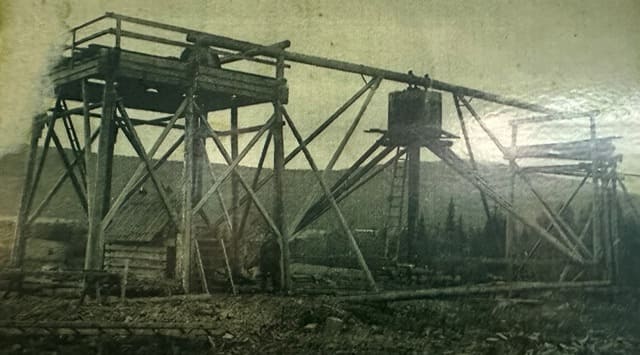You are here
History of Zhezkazgan field.



Tourist routes around Ulytau.
“Archaeological data irrefutably suggests that Zhezkazgan is one of the cradles of the copper-bronze culture of mankind - the culture of the first use of metal in human life. Over a million tons of rich ore were mined thousands of years ago by ancient miners from the depths of Zhezkazgan.”
K. A. Satpaev.
History of Zhezkazgan metallurgy.
The history of the Zhezkazgan polymetallic deposit goes back to the deep past. The very name “Zhezkazgan”, translated as “Copper Mine”, says that people have been mining copper ore here since ancient times.
Thousands of years ago there was a large center for the extraction of copper ore, a powerful center of metallurgy. Here, in the second millennium BC, bronze was obtained, which became the main material for the manufacture of tools and weapons.
Compared to copper, bronze has a number of advantages - greater hardness, lower melting point, and a beautiful golden color. Axes, daggers, and jewelry were made from bronze. To produce bronze you need copper and tin. And ore with a high copper content and tin placers - all this was abundant in the Ulytau region.
The subsoil of Kazakhstan is especially rich in polymetals. Ore miners and metallurgists of the Bronze Age left their archaeological monuments in the form of ancient mine workings and metallurgical furnaces. “Archaeological data irrefutably suggests that Zhezkazgan is one of the cradles of the copper-bronze culture of mankind - the culture of the first use of metal in human life.
More than a million tons of rich ore were mined thousands of years ago by ancient miners from the depths of Zhezkazgan,” wrote the great scientist of Kazakhstan K.I. Satpayev. In 1950, during archaeological excavations in the Milekuduk tract, in the southern part of the Zhezkazgan mine, N.V. Valukinsky explored the sites of ancient copper smelting, identified a system of furnaces (crucibles) for smelting ores, found copper ingots, samples of coal, finely crushed oxidized ore, slag, crucible fragments, etc.
Who are these people who, in the era when the Egyptian pyramids were being built, the Trojan War was going on, in the vast expanses of the Eurasian continent, created objects of material culture from copper and bronze?
From the depths of history, the name of this mysterious people has been preserved - Chud. One involuntarily suggests a connection between the name of this people and the Chu River and the Chu-Ili Valley, where there are also tin deposits.
Obviously, the revelation of the secrets of Kazakhstan’s distant past must be sought in these places. In Russia, the first mentions of the presence of copper ore in the Ulytau Mountains were received at the end of the 18th and beginning of the XIXth centuries from reports of Major General von Traubenberg, Colonel Bentham, and representative of the Orenburg Border Commission G. Gens.
In the “Day Notes...” of Captain Nikolai Rychkov to the Kyrgyz-Kaisatsky steppe in 1771, it is reported that in the vicinity of the Ulutau Mountains along the Dzhezdy-Kengir River he discovered “a great abundance of copper ores dug by the ancient inhabitants of that country; “They also find signs of gold and silver ore.”
In 1768 - 1769, an expedition of the Academy of Sciences led by academician P.S. made a long journey across Siberia. Pallas. In 1809, he published a major work, “Physical Travels through Various Provinces of the Russian Empire,” which also noted the richness of the “Kyrgyz” steppe in silver, lead and copper ores.
At the end of the 18th and beginning of the XIXth centuries, attempts were made to study the ore wealth of the “Kyrgyz” steppe in more depth. In 1814 - 1815, the Orenburg military expedition under the command of Herman twice confirmed assumptions about the wealth of the Ulutau Mountains region in copper and lead ores.
The expedition of B.F. German in the vicinity of Mount Kurgashtau produced about 6 thousand pounds of lead ore. In the scientific work of A.I. Levshin “Description of the Kirghiz-Cossack or Kirghiz-Kaisach hordes and steppes,” first published in St. Petersburg in 1832, the following description is given:
“The branch of the Ulu Mountains, called Lead, deserves this name in all fairness. In it, on the right bank of the Karaturgaya River, two veins were explored in 1814, from which 6,086 pounds of ore were mined and brought to Troitsk. Among these were pieces of pure lead shine, each poods of 15.
The entire amount melted at the Miass plant produced 2,500 pounds of pure lead. In several places from this mine lies the so-called Copper Mountain, consisting of clay, porphyry and copper greenery, sometimes imbued with native copper. Ancient mines were found in it. 107 poods 13 pounds of ore taken from it delivered 7 poods 35 pounds of pure copper.”
This was the first smelting of metal from the ores of the Kazakh steppe, thousands of years after the “Chud” developments. The cost of these metals covered the expenses of the expedition. In fact, these are the first non-ferrous metals of pre-revolutionary Kazakhstan, smelted in factory conditions.
The expedition of I.P. Shangin in 1816 discovered poisonous ore deposits in the Kazakh steppe in the wake of ancient Chud mining, including in the Zhezkazgan region. All this was widely covered in the periodicals of that time.
Following the first expeditions, Russian merchant entrepreneurs flocked to the Kazakh steppe. The pioneer of the mining business in Central Kazakhstan was the merchant S.I. Popov, who built the first small lead-silver factory in the Kuu mountains in 1844.
On November 11, 1847, merchant N.A. Ushakov made applications to the Kokchetav district order for the discovery of six copper deposits in the Ulytau mountains: Pokrovsky (“Pokro”) with a total area of 500,000 square fathoms (2 square versts, or 2.3 square kilometers ), Krestovozdvizhensky (“Cross”) and Petropavlovsky (“Petro”), each with an area of 2 square versts, Zlatoustsky, Nikolsky and Spassky (on the Yeskuly hill), copper ore deposits in the Yeskuly, Kok-Dombak, Zhezdy-Kengir tracts and Zhanai, with a total area of 110 square versts).
Nikon Ushakov is a Russian merchant of the 2nd guild, the founder of the first enterprises of Russian colonial industry on the territory of Kazakhstan. In the middle of the 19th century, after the defeat of the troops of the last Kazakh Khan Kenesary, under the increased pressure of the military presence of tsarism, he bought the right to manage the lands of Zhezkazgan and Karsakbay from the biy Babyr Bokenshin, and then began work on the development of Zhezkazgan copper.
But his attempts to establish copper production were unsuccessful due to the enormous costs of transporting rich ore to the Urals and the Spassky plant. At the beginning of the twentieth century, his heirs sold the field to Anglo-French investors.
All these deposits passed under an agreement into the hands of a mining company for 100 silver rubles each. All deposits were leased from a Kazakh landowner from the Baganaly clan (Baganaly is one of the clans of the Naiman tribe of the Middle Zhuz, who inhabited the territories from the lower reaches of the Sarysu to its middle reaches in the east, to the Yesil River and Lake Korgalzhyn in the north), the volost governor of the Dzhurginsky volost of Kokchetavsky district of Batyr Bakanchik and biy of the same family Chiyak Tansybergenov for a period until copper production.
The agreements were certified in the Kokchetav district order on December 16, 1850 and approved by the Altai Mining Administration on January 27, 1854. Construction of the plant in the steppe far from populated areas required significant capital investments.
A company was created, which, in addition to Nikon Ushakov, included Yekaterinburg merchant-miners Aniky Ryazanov and Tit Zotov. Ryazanov Aniky Terentievich (1800 – 1857) – Ekaterinburg merchant of the 1st guild. One of the creators and founders of the Ryazanov, Balandin and other persons of the company, the highest approved in 1853, the company Ryazanov, Zotov and Ushakov (1852). Creator of the Spassky copper smelter near modern Karaganda with the aim of developing copper and lead ores, as well as coal.
The enterprise started by N. Ushakov required large capital expenditures. With allocated capital, the Spassky copper smelter was built in the Ak-Byurat-Adyr tract, which used ores mined at the Spassko-Voskresensky and Uspensky copper mines, and coal from an open deposit in the Karaganda-Basy tract.
As for the copper ore deposits in the Ulytau Mountains region, due to the great distance from the Spassky plant (about 500 kilometers), they were not developed under the Ryazanovs. Years passed. In order not to lose rights to copper ore deposits in the U ytau Mountains, the owners only checked them from time to time, collected pieces of rich ore from ancient dumps, etc.
This continued until the beginning of the XXth century. In 1903, the Zhezkazgan copper deposits were first visited by the Englishman West, who highly appreciated them. In 1904, the Zhezkazgan field was officially leased to the British from the Russian company of the Ryazanovs until 1909.
During this period, the British carried out preliminary reconnaissance and surveying. Having ascertained the prospects of the deposit, the British, with the help of von Stein, in January 1909 entered into a purchase and sale agreement with Ryazanov’s heirs in the amount of 260,000 rubles. n addition to the Zhezkazgan mine, they acquired ownership of an iron mine in the Eskula tract, 18 lime quarries and 4 coal deposits in the Baikonur tract. In 1904, under an agreement with von Stein, exploration work began here, and 21,000 pounds of copper ore were mined at the same time.
In 1904, the British became the owners of the Spassky-Uspensky copper mines and founded the Spassky Copper Ores Joint Stock Company. Subsequently, the British acquired the Zhezkazgan deposit for 260,000 rubles, as well as an iron mine in the Yeskula tract, lime quarries, the Baikonur coal deposits, and the Karsakpai-Asha tract.
In London, the Atbasar Copper Ores Joint Stock Company was organized with a capital of 250,000 pounds sterling. Joint Stock Company "Atbasar Copper Mines" is a company formed in 1906 in London for the purpose of developing the Zhezkazgan copper deposit, with an authorized capital of 250,000 pounds sterling, which later grew to 500,000.
In 1907, a lease agreement was concluded with von Stein and industrial exploration using diamond drilling began. The first results amazed experts: the ore contained from 6 to 32 percent copper. Subsequently, the British decided to subject the ore to analysis only if the determination by eye raised doubts.
In 1908, the English engineer Harvey visited the Zhezkazgan field. Upon returning to London, at a meeting of shareholders, he stated that the Zhezkazgan copper deposit is one of the largest in the world, the ore fields of which contain huge amounts of high-grade copper. In addition, next to it there is a rich coal deposit at Baikonur, which can provide the required amount of fuel.
But the major disadvantage is the great distance from the railway. An optimistic report from an experienced English engineer accelerated the development of the Zhezkazgan copper deposit and attracted new shareholders to it. Up to three hundred workers were involved in exploration work.
At the same time, between 1907 and 1909, 440,000 pounds of copper ore were mined. On January 1, 1909, the Ryazanovs transferred the Zhezkazgan copper deposits into the ownership of von Stein for 260,000 rubles.
In the same year, the Atbasar Copper Mines Joint Stock Company was organized in London with an initial capital of £250,000. Arthur Fell became the chairman of the board, Alexander Davidson became the director.
The shares were placed in England. Engineer Algernon Nobel was invited to provide technical guidance for the development of the field. In 1908, the Zhezkazgan field was visited by American specialists Titcomb and Simon, who also described the field as “unique.” And American entrepreneurs also invested their capital in the Atbasar business.
Intensive exploration work was carried out. In 1910 alone, 68 wells were drilled, of which 42% yielded rich ores and a thick ore body. 13 exploration mines were laid. The directors and main shareholders of the Spassky Copper Ores Joint Stock Company were members of the Atbasar Copper Mines Joint Stock Company.
By the beginning of 1911, 40% of the shares of the Atbasar enterprise were in the hands of the Spasskaya company. Recognizing the enormous value of the Zhezkazgan copper deposits, the board of the Spassky Copper Ores Joint Stock Company in 1913 acquired a controlling stake in the Atbasar Copper Mines Joint Stock Company.
As a result, in addition to the Spassky-Voskresensky copper mine with a copper smelter, the Uspensky copper mine, the processing plant in Sary-Su, the Saransky and Karaganda coal mines and two iron mines of Sasyk-Karasu, the Spassky Copper Ores joint-stock company became the owner of 21 allotments for copper mines in the Zhezkazgan tract, one iron mine in the Eskula tract, 18 lime quarries, 20 allotments of coal mines in Baikonur with an area of 23 square kilometers and the construction of the Karsakpai copper smelter - all with a total area of 4196 acres.
At the end of December 1912, at a meeting of shareholders, it was decided to build a copper smelter on the Perkins project in the spurs of the Ulytau ridge, in the Karsakpai tract on the left bank of the Kumola River. Here the river made a loop.
The project envisaged blocking the river with a small dam and creating a reservoir. Kumola is a river in the Bileuta basin. The river originates from springs at the foot of the Akzhal Mountains and flows into the Bleuty River on the right side. The total length of the river is 112 kilometers.
The banks are steep, the riverbed is winding and wide. It is filled with melt water once a year during the flood period, in early April, after which it is divided into separate reaches. The river has large tributaries: Sarybulak, Koygeldy, Kishkenesai, Ashchylysay.
A deposit of fluxes was discovered 40 versts from this tract, which made it possible to reduce the cost of their delivery. Already in 1914, it was planned to smelt 5,000 tons of copper (300,000 poods). By the spring of 1915 235 wells were drilled, over half a million tons of ore with an average content of 10.7% copper were explored. To supply the plant with ore, 18 mines were laid.
In the spring of 1913, about 300 workers arrived in Karsakpai. Every month their number grew in Karsakpai, and at the Zhezkazgan mine, and at the Baikonur mines, reaching 1,200 people. Work began with the preparation of building stone.
For this purpose, a brick factory was built. By the end of the year, several pits had been dug for industrial buildings and 15 adobe houses had been built. In 1914, 2 more residential buildings and some production facilities were built: a power station, a mechanical workshop, warehouses, etc.
At the same time, geological exploration work was carried out. From 1907 to 1915, the British drilled 135 wells in Dzhezkazgan with an average depth of 60 meters on an area of 90 acres. Explored copper reserves have already ensured the operation of the plant for 12 years, although exploration covered only a seventieth part of the main allotment area.
Moreover, only ore with a copper content of at least 10% was accepted for accounting. At the same time, the company in Baikonur was exploring for coal. Here, over the course of six years, 54 wells were drilled, and two working formations were identified.
The shallow depth of the deposit made it possible to develop the upper layer in shallow mines equipped with wooden headframes and horse-drawn gates. The smallest mines were served by manual gates. By 1918, proven coal reserves were sufficient to operate the plant for 12 years.
Experimental work was also carried out to determine the optimal methods of enrichment and processing of Dzhezkazgan ore. For this purpose, in May 1916, 1,124 pounds of ore were transported to the Sary-Suu processing plant on carts. Experimental work on the enrichment of Dzhezkazgan ore in factory conditions gave good results and served as the basis for the design of an enrichment plant to produce a thirty percent copper concentrate, which should go into the reverberatory furnace of the metallurgical plant.
Here, smelting should be carried out using gas from generators running on Baikonur coal with the addition of fluxes. With the subsequent conversion of the matte, that is, its purification from sulfur and iron impurities, blister copper was obtained.
ith the outbreak of the First World War, the demand and prices for copper increased sharply. This accelerated work on the construction of a copper smelter in Karsakpai. In the summer of 1915, the installation of trusses and floors for the smelting shop and processing plant began.
Construction was significantly hampered by the lack of a railway. It was necessary to connect the coal mines and the plant with a railway track. Transportation by tug to Karsakpai of ore from Dzhezkazgan and coal from Baikonur amounted to 14 kopecks per pood.
To connect the mine and mines with the plant by railway, after survey work, in the spring of 1915, construction began on a narrow-gauge railway with a total length of 120 versts. Stations were built in Karsakpai, Baikonur, and Dzhezkazgan. It was necessary to connect the Atbasar industries with the Tashkent railway, the nearest station of which was Dzhusaly (Zhosaly).
This transshipment base is located 400 kilometers from Karsakpay. Here the British rented a plot of land, built warehouses, workshops, and living quarters. About 1,000 carts were purchased to transport goods to the plant.
To transport goods, drivers from the local population with their own camels and horses were hired. Along the road, 15 - 20 kilometers away, pickets were created with the necessary supplies of food, water, and fodder. Delivery of one pound of cargo cost the Company 60 kopecks.
At the Dzhusaly station, several hundred thousand pounds of various large-sized cargo accumulated - equipment for the Karsakpai plant, which could not be transported by horse-drawn vehicles. It was necessary to build the Dzhusaly-Karsakpai railway, which required huge capital expenditures.
The British took a different route. From Dzhusaly station on the way to Karsakpai the first 13-verst section of the railway was laid. Five locomotives and 278 cars were mounted on it, occupying 2.5 miles of track. The carriages were loaded with 200,000 pounds of cargo. After moving the rolling stock to the front end of the railway, the free 10.5 km of rail track was remounted, and the caravan of locomotives and wagons moved forward to Karsakpai another 10.5 km.
Thus, the British expected to complete the entire journey in a year. The caravan set off on November 10, 1914, and arrived in Karsakpai on October 8, 1917, that is, three years later. The equipment that arrived was quickly installed.
However, the revolution and subsequent civil war radically changed the course of events. The British failed to complete the construction of the Karsakpai plant. They left the Kazakh steppes for a long time.
The copper smelter of the Atbasar Copper Ores joint-stock company (a company founded by the British) started operating only in 1928.

Authority:
Novikov Vladimir Yakovlevich.
http://novikovv.ru/kanish-satpaev/nachalo-zhezkazgana
Mukhtar Seitzhanov.
https://www.litres.ru/book/muhtar-seytzhanov/britanec-karsakbay-35735743/chitat-onlayn/
Photos by:
from the Kazakhmys Museum in Zhezkazgan.







